LEPIDOPTERA
PAPILIONIDAE Latreille,1802
PAPILIO Lnnaeus, 1758
Papilio machaon Linnaeus, 1758

Papilio machaon machaon Linnaeus, 1758
· RANGE. All the Palaearctic Region and N. America.
· DISTRIBUTION AND VARIATION. A great number of subspecies/varieties of this widely distributed butterfly species have been described. However, throughout the range, clinal variation can be traced in most cases and therefore not all the forms are "true" subspecies. At present, the following more or less obvious subspecies can be recognized: ssp. machaon Linnaeus, 1758 - the central European part; ssp. gorganus Fruhstorfer, 1922 - the S. European part, the Urals, the Caucasus Major; ssp. lapponica Verity, 1911 - the N. European part; ssp. syriacus Filer, 1939 - the Caucasus Minor, the Armenian Highland, the Talysh Mts.; ssp. weidenhofferi Seyer, 1976 - Kopet-Dagh; ssp. centralis Staudinger, 1886 - Turan, W. Tian-Shan, Ghissar, Darvaz, Alai, the W. Pamirs; ssp. ladakensis Moore, 1884 - the E. Pamirs; ssp. oreinus Sheljuzhko, 1919 - Tian-Shan; ssp. orientis Verity, 1911 - the Altai, Sayan, Transbalkalia, the Amur region (north), the Far East; ssp. ussuriensis Sheljuzhko, 1910 - the Amur region (south), the N. and central Ussuri region; ssp. schapiroi Seyer, 1976 - the S. Ussuri region; ssp. sachalinensis Matsumura, 1911 - Sakhalin; ssp. septentrionalis Verity, 1911 ( = chishimana. Matsumura, 1928) the Kuril Islands; ssp. kamtschadalus Alpheraky, 1897 - Kamchatka; ssp. aliaska Scudder, 1869 - the Chukot Peninsula.
· HABITATS AND BIOLOGY. Preferring open habitats in forest, forest-steppe and mountain landscapes. In the mountains, it is common up to 2,700 m a.s.l., but occasionally it is found also much higher, up to 4,700 m a.s.l. Flight period: April - November depending on climatic conditions, in one to three generations. Males are markedly territorial, the center of an individual territory lying at the dominating elevation. Host plants: Apiaceae, in the temperate zone most commonly Carum, Seseli and Pimpinella, but the range of host plants is wide and also includes Daucus, Prangos, Ferula, Haplophyllum, Achillea, Artemisia, Ligusticum, etc., including even Mentha. In some populations, there is a two - or three-year long pupal diapause.
Photo and text: Guide to the BUTTERFLIES OF RUSSIA and adjacent territories Volume 1. PENSOFT, Sofia - Moscow. 1997